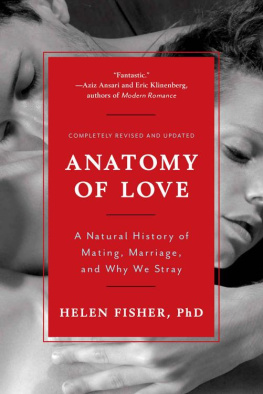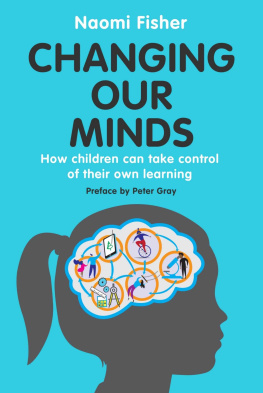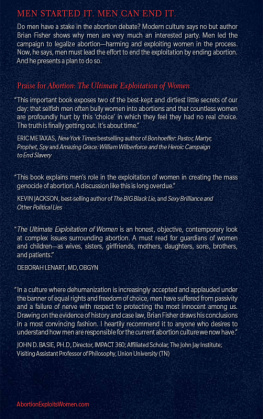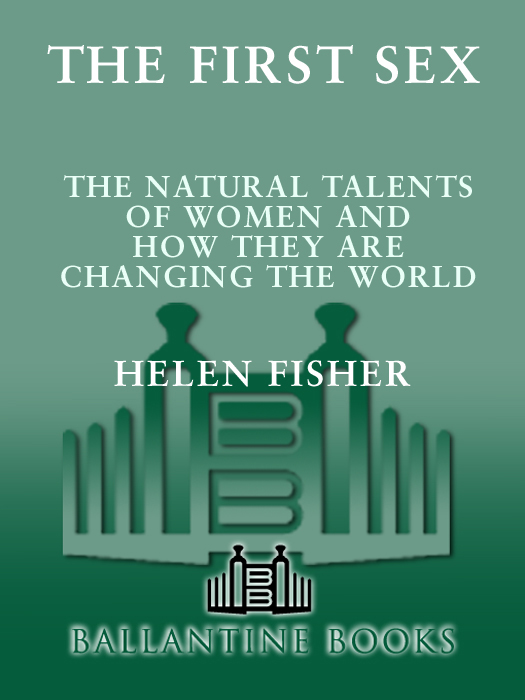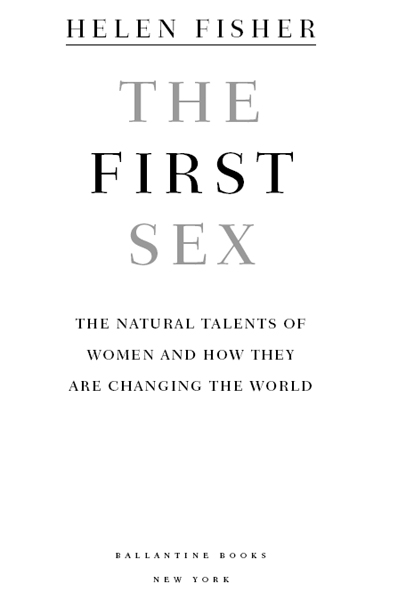More praise for The First Sex
Striking An original and often quite enjoyable book.
The New York Times Book Review
Thought-provoking Were not getting older, were getting better.
USA Today
Full of interesting anecdotes, lively commentary, and a wealth of information.
The Dallas Morning News
This controversial compendium of bold statements, supported by vast amounts of biological and anthropological research, is persuasivepartly, no doubt, because Fishers writing style makes the material accessible.
BookPage
Provocative Fisher, an anthropologist at Rutgers University, synthesizes the insights of her own discipline and those of psychology, sociology, ethnology, and biology into good news for women.
Publishers Weekly
ALSO BY HELEN FISHER
Anatomy of Love: The Natural History
of Monogamy, Adultery, and Divorce
The Sex Contract: The Evolution
of Human Behavior
A Ballantine Book
Published by The Ballantine Publishing Group
Copyright 1999 by Helen Fisher
All rights reserved under International and Pan-American Copyright Conventions. Published in the United States by The Ballantine Publishing Group, a division of Random House, Inc., New York, and simultaneously in Canada by Random House of Canada Limited, Toronto.
Grateful acknowledgment is made to the following for permission to reprint previously published material:
Elizabeth Barnett for the Edna St. Vincent Millay Society: Lines from I too beneath your moon, almighty Sex and excerpt from Sonnet XXIX of Fatal Interview by Edna St. Vincent Millay. From Collected Poems, HarperCollins. Copyright 1931, 1939, 1958, 1967 by Edna St. Vincent Millay and Norma Millay Ellis. All rights reserved. Reprinted by permission of Elizabeth Barnett, literary executor.
Farrar, Straus & Giroux, Inc.: Eight lines from Valediction from Poems 19651975 by Seamus Heaney. (Published in the U.K. as Death of a Naturalist) Copyright 1980 by Seamus Heaney. Rights in Canada and the open market are controlled by Faber and Faber Limited. Reprinted by permission of Farrar, Straus & Giroux, Inc. and Faber and Faber Limited.
Harcourt, Inc. : Excerpt from True Love from View With a Grain of Sand by Wislawa Szymborska. Copyright 1993 by Wislawa Szymborska. English translation by Stanislaw Baranczak and Clare Cavanagh copyright 1995 by Harcourt, Inc. Reprinted by permission of the publisher.
HarperCollins Publishers, Inc. and Faber and Faber Limited: Excerpt from Three Women: A Poem for Three Voices from The Collected Poems: Sylvia Plath, edited by Ted Hughes, pp. 176187. Rights throughout the world excluding the United States are controlled by Faber and Faber Limited. Reprinted by permission of HarperCollins Publishers, Inc. and Faber and Faber Limited.
Shambhala Publications, Inc. : Song by Tzu Yeh from The Erotic Spirit, edited by Sam Hamill. Copyright 1996. Reprinted by arrangement with Shambhala Publications, Inc.
Ballantine and colophon are registered trademarks of Random House, Inc.
This edition published by arrangement with Random House, Inc.
www.randomhouse.com/BB/
Library of Congress Catalog Card Number: 99-91716
eISBN: 978-0-307-76611-3
v3.1
For Ray Carroll
If ever the world sees a time when women
shall come together purely and simply for the benefit
and good of mankind, it will be a power such as
the world has never known.
MATTHEW ARNOLD
ACKNOWLEDGMENTS
I thank my friend Ray Carroll for his breadth of knowledge and his sophisticated insights. I thank my agent, Amanda Urban, for her astute guidance during the conception of this project and her unflagging enthusiasm for this book. I thank Kate Medina, my editor, for her critical eye and valuable commentary. I am indebted to Edie Weiner and Arnold Brown, trend analysts, for allowing me to sit in on their think-tank sessions about the future. I am grateful to Bob Alford, Arnold Brown, Ray Carroll, Fletcher Hodges, and Barbara Pillsbury for their careful reading of the manuscript, and to Michelle Cristiani, Janel Tortorice, and Jenny Overman for gathering some of the research materials. I also thank my friends and colleagues who took the time to read sections of the book or had valuable conversations with me during the years of writing: Judy Andrews, Art Aron, Sydney Barrows, Laura Berman, Laura Betzig, Lucy Brown, Matt Clark, Ellen Dissanayake, Perry Faithorn, Bob Fisher, Ron Fletcher, John French, Larry Frolik, Lynn Goldberg, Jack Harris, Mariko Hasegawa, Toshikazu Hasegawa, Kim Hill, Gene Katz, Laura Klein, Jane Lancaster, Edwin Laurenson, Marie Lugano, Deb Masek, B. Kay Manuelito, Anne Moir, Peter Moore, Merry Muraskin, George Newlin, Roger Pasquier, Michelle Press, Audrey Redmond, Carolyn Reynolds, John Munder Ross, Pepper Schwartz, Gregg Simpson, Barb Smuts, Susan Stautberg, Fred Suffet, MacGregor Suzuki, Martin Tandler, Barbara Tober, Edie Weiner, Franny Whitney, Lorna Vanparys, Jeff Zeig, Caroline Zinsser, and my associates at Rutgers University. I also thank Meaghan Rady, as well as Sally Marvin, Sybil Pincus, Carol Schneider, and everyone else at Random House who contributed to the publication of The First Sex.
CONTENTS
INTRODUCTION
DEEP HISTORY
An Immodest Proposal
INTRODUCTION
DEEP HISTORY
An Immodest Proposal
There is only one way of seeing things, and that is seeing the whole of them.
JOHN RUSKIN
W hat is a woman? Simone de Beauvoir asked this question in her celebrated 1949 book, The Second Sex. She believed that a woman is solely the product of economic and social forces. As she said, One is not born, but rather becomes, a woman.
Times have changed since Beauvoir wrote these words. A great deal of scientific evidence now demonstrates that all human beings emerge from the womb with circuits in the brain that enable them to act in human ways. Moreover, in some fundamental respects the sexes are not alike. For millions of years, men and women did different jobs, tasks that required different skills. As days turned into centuries and natural selection weeded out less able workers, time carved subtle differences in the male and female brain. A woman is born a woman.
I am a clone; I am an identical twin. My twin sister and I are alike in many ways and different in many others. We laugh alike and our gestures are uncannily similar, but I am an anthropologist and she is a hot air balloon pilot and a painter. Because of this lifelong personal experience, I am acutely aware that parents, teachers, friends, jobs, and myriad other cultural forces dramatically influence how one thinks and acts. Environment and heredity are eternally intertwined, locked in a pas de deux. No two human beings are alike.
Yet men and women emerge from the womb with some innate tendencies and proclivities bred on the grasslands of Africa millennia ago. The sexes are not the same. Each has some natural talents. Each is a living archive of its distinctive past.
Beauvoirs central tenet was correct, however. She endorsed the nineteenth-century view that social traditions emerging during our farming ancestry had forced women into a secondary place in society.


